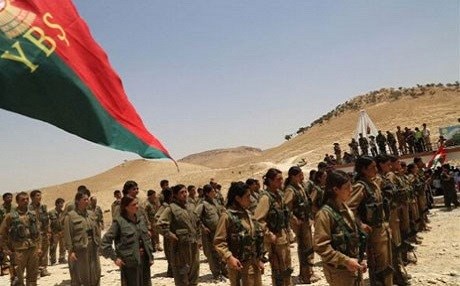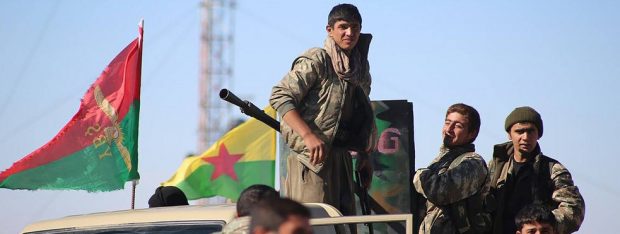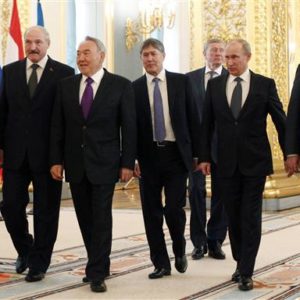During the morning of Friday 3 March, clashes broke out between the PKK (Kurdistan Workers’ Party)-linked Sinjar Resistance Units (YBŞ) and the Kurdistan Democratic Party (KDP)-linked Rojava Peshmerga units consisting of Syrian Kurds, while the latter made an attempt to enter the town of Khanasor in the northern sub-district of Shingal district. Lengthy shootouts broke out between the two which reportedly resulted in seven casualties and a number of wounded combatants. The clashes broke out the day after some 500 Rojava Peshmerga were deployed in Sinuni, which is under shared control of the Kurdistan Regional Government (KRG) and the PKK and moved west of the town, making an attempt to enter nearby Khanasor, which is under the sole control of the PKK. As videos and photos from the scene of the clashes hint, both sides were already dug up in trenches. While the situation remains unclear, it is apparent that the KDP made an attempt to establish an armed presence in Khanasor. Clashes ended on the same day and there have been negotiations between the KDP Peshmerga commanders and the PKK in the town of Shingal to defuse the situation, both sides reportedly agreeing to a ceasefire. The talks are expected to continue.
The district of Shingal has been a source of friction between the PKK and the KDP since August 2014 when Peshmerga forces fled facing Islamic State’s (IS) advances and the PKK promptly came to aid the Yazidi population. The PKK subsequently began to build its political and governance structures in the area, challenging KDP’s authority. An attempt to deploy Rojava Peshmerga in Khanasor, which has been under the full control of the PKK since 2014, occurred after intensifying calls from the KRG for the PKK to withdraw its forces from the Shingal district.
KDP, Rojava Peshmerga and Syrian Connection
Rojava Peshmerga are a part of the Zerevani Peshmerga, thus answering to the Ministry of Peshmerga and ultimately to the president of KRI. The force has been receiving training from the KDP and the US, and are also backed by Turkey. As PAX for Peace asserts, Rojava Peshmerga has already been present in the northern sub-district in 2016, being deployed in several spots alongside the Syrian border. This deployment did not cause any major problems since they mostly stayed out of the PKK control areas. Given the command line of the Rojava Peshmerga, it is highly unlikely that the decision to enter Khanasor came independently from the KDP leadership.

Shingal Protection Units (YBS)
The Rojava Peshmerga are tied to the Syrian Kurdish opposition party Kurdish National Council (KNC) led by Ibrahim Biro, which has close ties to the KDP, and thus stands in opposition to the PKK in Syria. Their declared manpower is 3000–7000 fighters. There have been several attempts to reach a power-sharing agreement between the KNC and Rojava administration sponsored by the KDP (June 2012, December 2013 and October 2014) but none of these materialised. Recently, there have been renewed negotiations about Rojava Peshmerga deployment in Syria. Currently, the KNC chairman Ibrahim Biro is in the US to negotiate on the matter. Previously, it was reported that the US has had reservations regarding Rojava Peshmerga deployment, also fearing infighting between the PKK-linked forces it supports in Syria, and the Rojava Peshmerga. Rojava administration has naturally opposed such plans since it would challenge their monopoly. On the other hand, the US said in December that the PKK ‘should have no role in Shingal’, however, without referring directly to their affiliates. Moreover, the deployment comes days after president Barzani’s visit to Turkey on 26-27 February. Ankara considers Rojava Peshmerga a friendly force and views it as a useful counterweight to PKK’s dominance in northern Syria.
The rivalry between the KDP and the PKK has so far (since the 1990s) been non-violent and clashes in Khanasor mark its first violent manifestation. These events once again highlight the need for a negotiated solution of political arrangements between the KRG and the PKK for the Shingal district since the prospect of yet another armed confrontation after IS hangs over the Yazidi population, which ironically both the KDP and the PKK claim to protect. The competition is, however, intimately connected to Syria, where the KDP wishes to challenge the monopoly of the PKK, while the PKK wants to remain the sole force.
The PKK’s Presence in Shingal: A New Reality
Since early 2015, the PKK began to build a similar governance model in the parts of Shingal district under its control as we see in Rojava. As the author’s conversations with Yazidis suggest, many within the community feel that they were betrayed by the KRG which did not make enough effort to protect them from IS atrocities. As a result, PKK’s idea of ‘democratic autonomy’ for the Shingal district in which Yazidis rule and defend themselves found fertile ground. Especially in the western parts of the district, the PKK built governance structures ranging from local councils up to ‘cantonal administration’ embodied in the Self-Administration Council and even recruited internal security force, Asayish. ‘Shingal for Yazidis’ indeed resonates positively with a significant portion of the population and the PKK successfully utilizes a hearts and minds approach rather than coercion. However, the PKK’s radical leftist ideology could prove increasingly incompatible with a conservative Yazidi society in the longer-term.
The PKK has invested a considerable amount of energy into building its structures in Shingal and it is unlikely that it would accept a complete withdrawal from the area. Moreover, as the author’s interviews suggest, it apparently pursues the establishment of a permanent base in the Shingal mountain range which serves as a highly defendable safe haven overseeing the border with Syria.
Preventing the War?
Zekî Şengalî, PKK commander from Shingal, labelled clashes as not a ‘birakuji’ (Kurdish infighting) but as a ‘war of betrayal’. The PKK leadership further suggested in a statement that the fight was initiated after president Barzani’s visit to Turkey, calling Rojava Peshmerga Turkish proxies and vowing to defend Yazidis against them. That may be an explanation accepted within the PKK and its sympathizers but can hardly be maintained for the majority of Kurdish population, or the international community. The KDP seems to maintain the line of PM Nechirvan Barzani and his calls made in December 2016 for the PKK to leave to avoid military confrontation in the area. The Ministry of Peshmerga, now under KDP control, issued an inflammatory statement asserting that the Peshmerga move and deploy wherever they want to inside the KRI, referring to the Shingal district (which is indeed not part of the KRI, according to Iraqi law). The government in Baghdad itself has not so far issued any comments on the events in Shingal. Both the PKK and KDP put themselves at severe risk of losing wider support by inciting fighting within the ‘Kurdish house’.
Recommendations
While there is a strong rivalry between the KDP and the PKK, both would find it difficult to justify open conflict to their constituencies. Following the same uncompromising stances is indeed not constructive.
The KDP should come to terms with the PKK’s entrenched presence and considerable support; and the fact that this is hardly going to vanish overnight by the use of force. Similarly, the PKK should be open to compromise with the KDP. An overarching agreement not only on Shingal but also on Rojava with both sides’ interests being addressed is needed. Given the mistrust and strongly contradictory interests, fear for losing popular support does not seem to be a sufficient motivation.
In this regard, the US has a unique position to mediate and put pressure on both sides to strike such a deal since both the PKK affiliates in Syria and the KRG are its principal anti-IS allies in the region. The US has already been engaged, sending signals to both that Washington does not wish for confrontation. If the US wishes their allies on the ground to focus on combating IS and stabilization rather than lashing out against each other, these efforts should be intensified.
Tomáš Kaválek is a Visiting Fellow at the Middle East Research Institute (MERI). He completed his bachelor studies in Political Science and Security and Strategic Studies at the Faculty of Social Studies at the Masaryk University in Brno, Czech Republic in 2013. Tomáš undertook his MA in the field Security and Strategic Studies at the Masaryk University in 2014. Currently, he is pursuing his Ph. D. in Political Science at the Masaryk University. Since 2015, he has been working as a Middle East and North Africa analyst in a Prague-based think-tank Association for International Affairs (AMO). In his researches, Tomáš focuses on the Middle Eastern politics, armed conflicts in the region, conflict resolution, and on the Kurdish politics in the Middle East.
Article Citation: Kaválek, T. (2017) Yet Another War in Shingal: The Sword of Damocles, MERI Policy Brief. vol. 4, no. 3.







